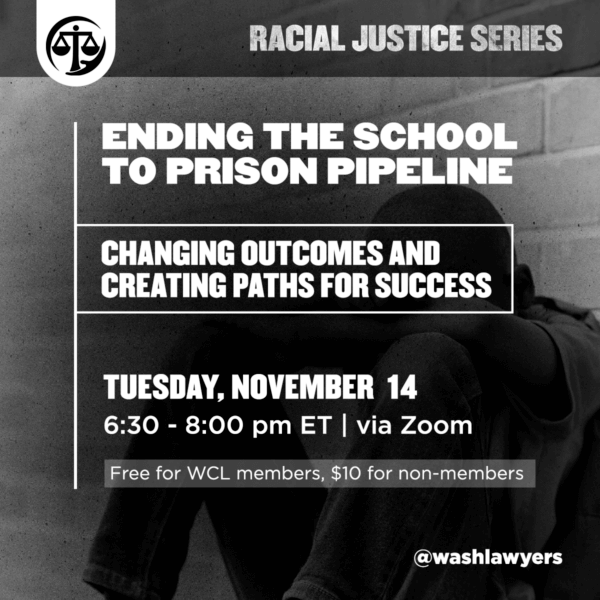
Racial Justice Series: Ending the School to Prison Pipeline: Changing Outcomes and Creating Paths for Success Recap
On Tuesday, November 14, 2023, panelists discussed the ongoing consequences of the “School to Prison Pipeline.” We broke down the narrative, highlighted the ongoing and significant effects on students of color, particularly those with disabilities, and laid out action steps for students, educators, and legal professionals to promote systemic change and end disparate discipline practices.
Our discussion will be led by:
- Kaitlin Banner, Deputy Legal Director, Washington Lawyers’ Committee for Civil Rights and Urban Affairs
- Akela Crawford, Director of Legal Services, Advocates for Justice and Education
- Seema Gajwani, Special Counsel for Juvenile Justice Reform; Founder & Chief, Restorative Justice Program, DC Office of the Attorney General
- Moderator: Henry Floyd, District of Columbia Commission on Human Rights, Adjunct Professor Georgetown University Law Center, and Washington Council of Lawyers Board Vice-President.
The conversation began with each panelist speaking from their experiences to the underlying programs that contribute to the school-to-prison pipeline. All panelists agreed that the largest underlying issue is a lack of resources for schools to create safe environments for all their students.
Schools should be a place to not only learn in the classroom but also to learn how to navigate being a part of the greater community. Schools are supposed to be a safe, equitable space for children and teenagers to make mistakes, learn from them, and go on to live healthy and productive lives.
Instead, we are seeing schools have issues with bias and discriminatory practices toward Black and brown students as well as students with disabilities and those from low socioeconomic means. These students are more likely to be subject to severe disciplinary practices such as suspensions and expulsions for behaviors better addressed by supporting their mental, emotional, and behavioral health and wellbeing.
The practice of severe discipline is a reflection on both schools’ culture and lack of resources. Culturally, there is not a reliance on researched based approaches to navigating trauma, mental illness, and disability support. Instead, schools push out students through suspension or expulsion, arguing it’s for the “safety of the school environment,” even if the student’s behavior doesn’t rise to that of a threat to the environment.
Now, schools find themselves even less prepared to support students as they continue to navigate the return from virtual learning during the pandemic. The pandemic has shown to be a period of lost learning and lack of connection. Students feel less connected to schools and their communities. The schools are pushing to go back to business as usual after such a seismic change and resources are not geared to address the trauma and behavioral impacts of mental illness or disabilities. One panelist remarked that, “a kid would rather be seen as a bad kid than a dumb kid.” With the loss of learning from the pandemic, students are experiencing a huge blow to self-esteem; they don’t believe they can be successful, causing greater instances of behavioral issues.
The conversation continued with schools’ insufficient resources and the related issue of police presence in schools. Police in schools create a direct connection from the school system into the criminal system. There is a misconception that police in schools are there as counselors, mentors, or teachers. The reality is that police officers are trained and hired to identify crime and enforce the law. Police intervention in schools is extremely traumatizing and harmful for not only the students but also their families.
When looking for resources that would better suit the needs of schools and students, the vision is to have trained professionals in the positions we think police are filling: mentors, counselors, and teachers. Students need support from adults that can help them, not intervention from the criminal system as they try to navigate their connection to their communities.
Our panel also touched more specifically on the experiences of students with disabilities. Our panelists highlighted the Individuals with Disabilities Education Act (IDEA). This law specifically seeks to ensure that students with disabilities are not removed from schools and receive the resources and support they need to thrive. While this law seems to address issues schools face, there is also an issue of enforcing it. DC’s Office of the State Superintendent of Education (OSSE) released a State of Discipline Report in June 2023 that illustrates the lack of enforcement. One example includes several schools that do not have any mental health staff; they handle students’ behavioral issues, including those of students with disabilities, using police presence.
Our panelists then turned to the role of legislation and advocacy in ending the school-to-prison pipeline. Legislation exists in this space, but ongoing funding of the resources and enforcing the rules present challenges. The OSSE report also discusses other legislation that is meant to address these issues and where those laws fall short.
Given the shortcomings of legislation, advocating in this space becomes very important for individuals seeking protection. Our panelists pointed to the 14th Amendment, which provides students with the right under the Due Process Clause to receive notice about the disciplinary action and a right to a hearing, as one of the most important protections. All students have a property interest in being able to attend their local schools. Therefore, schools cannot remove or involuntarily transfer students without giving them notice and a proper hearing. Being heard gives the students a better chance to stay in school, build empathy with their community, and go on to live a productive life.
Our conversation flowed into the impact of restorative justice practices for schools and students. Restorative justice is a theory of justice that emphasizes repairing the harm caused by criminal behavior. It is a victim-centered approach to addressing crime and conflict, which provides the victim and the young person who caused harm a chance to opt into a facilitated conversation about what happened, how everyone was affected, how the harm can be repaired, and what needs to happen to resolve the matter so that it never happens again. Restorative justice provides a space where crime victims have a voice and agency; it offers a chance to the young person to learn about the impact of their behavior, build empathy, and strengthen their consequential analytical thinking.
It has been found that young people in the criminal system have worse outcomes not only in the system, but for the rest of their lives. Moreover, severe disciplinary practices and the current criminal system that we use to address behavior in schools makes the behavior worse, that cycle needs to be changed. Turning toward restorative justice is turning toward an ancient practice originating with indigenous peoples from all over the world that asks someone that does something wrong to face the consequences and try to make it right. The most modern versions of restorative justice have been evaluated and research has found they reduce recidivism rates.
Beyond recidivism reduction, restorative justice helps children build empathy, learn to apologize and think about the consequences of their actions, and allows them to be a part of the solution. It allows students to feel safe and create security and be a part of the safety in their community.
Building a safe community that students are invested in is key to supporting the next generation. Students are trying to plug in, most continue to go to school even when they don’t feel safe because they want community. However, schools lack of accountability for a safe environment. The amount we invest in schools shows the amount we value both education and the students receiving that education everyday. You can learn more by reviewing the School Health Index published by the Center for Disease Control and Prevention.
- Our conversation concluded with a call to action.
- A concrete path you can take is attending Budgeting and Oversight Hearings. These forums provide a space to comment on the effectiveness of the laws and what you see as their practical impacts on everyday life for all people. Not sure how to start? Advocates for Justice and Education, Inc. (AJE) has trainings and workshops that can help.
- Call your representatives! Remind your representatives of your priorities and what you’d like to see from education reform.
- Finally, you can be a part of the cultural change. To help instill restorative justice practices in schools, learn more about how you can get involved in your child’s school or your local community’s education system to advocate for a cultural shift away from severe discipline and toward restorative justice.
Thank you to our panelists for their incredible insights and to everyone that was able to join us! Be a part of the change and end the school-to-prison pipeline. #RacialJustice.






